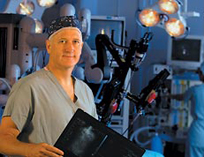Prostate Cancer Surgery - Clinical Outcomes
Advancing robotic surgery through evidence-based research
In June of 2002 Dr. Ahlering performed the first minimally invasive robotic-assisted prostatectomy in Southern California for prostate cancer and has performed more than 1000 robotic-assisted laparoscopic prostatectomy procedures for prostate cancer patients. The University of California, Irvine experience is one of the oldest and most prestigious programs in the world in the field of prostate cancer surgery.
UC Irvine, located in Orange County California, is the 2nd most published academic institution in literature relating to robot-assisted radical prostatectomy. Since the robotic program inception, Dr. Ahlering and his team have written more than 100 scientific publications, abstracts and book chapters specifically on prostate cancer and new advancements in techniques for robotic prostatectomy. (see below).
Perseverance of the surgeon to improve existing technical methods and to develop new techniques are important standards that UC Irvine employs. We view validated methods of measuring patient follow-up in the assessment and reporting of surgical outcomes, as essential tools to measure the true progress of robotic technology. Patients will be asked to fill out questionnaires before and after the operation to track outcomes. In addition, we currently are running numerous cutting edge basic science and translational research projects which we may offer patients the opportunity to become involved in if they choose.
Achieving the Trifecta
Three landmark endpoints of radical prostatectomy have emerged known as the trifecta: cancer control, potency and continence. More than ever before robotic prostatectomy offers patients the chance to achieve the trifecta. Trifecta Video: Acheiving the Trifecta
Prostate Cancer Surgery - Removal
Historically, the overall rate of margin positivity of robotic prostatectomy is 19%. More importantly, in men whose cancer is confined within the prostate, the apical region was correctly visualized and dissected, resulting in very low 6% positive margins. Prior to the da Vinci robot, it was very difficult to make such a clean and refined excision of the apical region of the prostate.
At UC Irvine we discovered that the fat that lies on top of the prostate contains lymph nodes which can result in improved pathologic staging. We routinely perform an anatomic excision of this fat and send it for separate pathologic analysis.
Preservation of Potency
A major focus of Dr. Ahlering's research has been dedicated to preservation of erectile function without compromising cancer control. Historically, most surgeons were using thermal energy (electrocautery) to stop bleeding during nerve dissection. It has become increasingly clear through our research that thermal energy is damaging to erectile nerves.
In November 2004, UC Irvine published and presented our new robotic technique for preserving the nerves for potency without the use of electrocautery at the 2004 World Congress of Endourology. This work was made especially significant when a paper published by the John Hopkins group showed a pronounced delay in the return in potency in dogs, with the use of electrocautery near the potency nerves.
We recently published the early results of our new technique to avoid damage to the potency nerves in the 2006 July/August issue of Journal of Endourology. In addition to thermal injury, it has becoming increasing clear that potency is also related to the degree of erectile nerve trauma caused by surgical manipulation of the nerves (stretching, cutting) and associated inflammation. Currently we find ~32% of pre-potent men <66 yrs with unilateral or bilateral nerve preservation return to erections firm enough for intercourse within 3 months and ~60% after 9 months, and 90% at 24 months.
Continence
Dr. Ahlering has developed new techniques to improve continence as well as adopted and modified a technique recently developed in Europe. A running single knot suture for the urethral anastomosis was co-developed by Dr. Van Velthoven and Dr. Ahlering in 2003. This has now become the standard method for creating the urethral anastomosis.
A new surgical technique which appears to play a role in achieving continence is stabilization of the posterior urethral plate (The Rocco reconstruction). In this technique, the bladder is secured very close to the urethra prior to creating the anastomosis to relieve tension. Taken together, these modifications to the standard robotic prostatectomy have resulted in a more rapid time to pad free status and a reduction in blood in the urine. The rate of return for pad-free urinary control in men is ~50% at 3 months and ~75% at one year after surgery.
